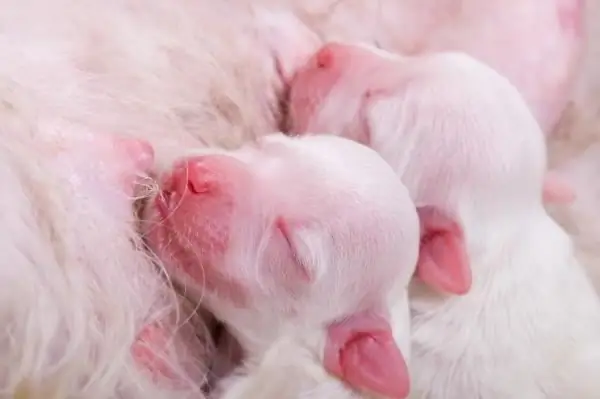2026 Author: Priscilla Miln | [email protected]. Last modified: 2025-01-22 17:55:27
The question of how long dogs live cannot be answered unequivocally, because it depends on many factors. Among them, of course, are the living conditions of the dog, its pedigree data and genetics, that is, predisposition to certain diseases.
Let's dwell on each of these points in more detail.
What is the lifespan of dogs?
Unfortunately, the age of a four-legged friend is not comparable to the age of his master. Nature did not reward the faithful companions of man with the longevity of parrots and turtles (after all, it is known that some species of parrots live up to 70, and turtles even up to 200 years).

The absolute, officially registered record of longevity among dogs has been recorded. It belongs to Maggie, a representative of the Australian Kelpie herding breed. She lived happily on a farm in Victoria for 30 years. Another, now still living "old woman", also an Australian named Bluey, is already over 29 years old. In terms of human age, this is 200 years, no less!
But such numbers are rare. On average, the age of dogs that have lived to advanced years is 12-14 years old.
Age comparison
For some reason, it is generally accepted that 1 year of a dog's life is equal to 7 human years. In fact, this is not true - after all, a one-year-old female, unlike a seven-year-old child, can already bear offspring.
How long do dogs live on average compared to humans? Canine childhood passes quickly, and adolescence ends when the animal passes the first year and a half. This conclusion was made by the American scientist in the field of cynology B. Foster. According to his research, the gradation of the dog's age over time changes downward: for example, a two-year-old dog is already 24 years old by "human" standards, a four-year-old dog is 36 years old, a six-year-old dog is 42, a 7-year-old dog is 49 years old, etc. A ten-year-old dog is comparable to an elderly person of 65 years old, and a 13-year-old is comparable to an octogenarian old man. Accordingly, if your four-legged pet has lived for 14-15 years, then it can be safely considered a long-liver.
Food
This is one of the most important factors in how long dogs live at home. A complete diet should cover the need of your friend's body not only for the intake of proteins, fats and carbohydrates, but also for minerals and vitamins.
At the same time, many dog breeders know that it is harmful to overfeed a dog living at home - this leads to obesity and various ailments associated with this condition.

Most diseases can be avoided if the animal is properly fed. For example, there is a special line of food for sterilized and neutered dogs - because they are less active and more prone toa quiet pastime (by the way, there is a reasonable opinion that dogs subjected to sterilization live longer and get sick less). If the owner, for example, constantly feeds his bitch, as if she had just brought offspring, then, most likely, she is in danger of obesity.
Some breeds are particularly prone to overeating, while many are naturally inactive and prefer sleep to play. Therefore, how many years a domestic dog lives, say, a pug, largely depends on its owner.
When a pet is found to have a disease or predisposition to any disease, a competent dog breeder today in most cases can minimize the risk of its development. Special dry food, canned food or natural food prepared in accordance with the recommendations of the veterinarian, proper care - all this should contribute to the proper development of the body and maintaining the well-being of the four-legged friend.
If the dog lives on the street
Lifestyle - and this point is also important to consider when answering the question: how long do dogs live. Some people think that a dog living outside the house is not as sissy as an apartment dog: its immunity is stronger, it is less prone to disease and is more adapted to survival. In fact, this is not true at all.
Female dogs, unlike indoor dogs, are deprived of proper nutrition, their body is weakened, often there is a lack of weight and digestive problems due to poor-quality food - because they are forced to get their own food, rummaging through garbage containers and scouring landfills.

In addition, in the absence of a shelter, street dogs are often cold, constantly exposed to danger from the outside and often come into contact with sick animals. Finally, determined only to survive, they are under constant stress.
How long do mutts live?
It is wrong to assume that outbred dogs live longer. All of them are very different in appearance. Depending on the blood types that predominate in different individuals, they can be both small and large.
There are even statistics, according to which "nobles" serve their masters longer. But this only confirms the fact that it is becoming increasingly difficult to meet an absolutely he althy animal among representatives of noble blood.
As for the fate of street-dwelling feral dogs, it rarely works out well. It is difficult to say for sure how long mutt dogs live in such conditions - most of them, having caught some kind of canine disease, do not live to a respectable age.
If your pet is kept at home
For an animal, especially a young one living in a house or apartment, physical activity is important. And if you have a house with a plot where the dog can run around, then this problem is solved. And for those who have a dog in the apartment, all that remains is to regularly walk it, trying to ensure that these walks are sufficient in duration.
Of course, there are several dog breeds that can be kept to a minimum. Enough and half an hour a day. They easily adapt to life in a city apartment and withpuppyhood are taught to relieve themselves on a diaper or in a tray. They have enough space even in small rooms. In addition, it is believed that communication with the owner and playing with him properly develop them intellectually and compensate for informational hunger.
These are the most decorative miniature breeds. They were bred as household companions and traveled mostly in the arms of their owners. Among them, for example, the so-called "pocket" - Chihuahua, Shih Tzu, Japanese Chin, Pomeranian, Japanese Crested. Apparently, this is why these breeds are so popular among city dwellers today.
True, the above does not apply to very small, but naturally active dogs - dachshunds and terriers. We must not forget that these are still dogs bred for hunting, and in order to develop, they need to move more.

Long-term walking and more free space for it require animals that were once created for security, hunting, herding or riding work. The need for movement in such dogs is inherent. For walks, for example, an Alaskan Malamute, a Collie or a German Shepherd, a cramped little garden in the courtyard of the house will not be enough.
It is necessary to walk with such a dog for at least two hours, dividing them into at least a couple of exits (with an interval between them of at least 12 hours). Training and classes on a special site will also not be useless.
Finally, it is desirable to know the history and "program" of the kennel where the puppy was purchased. Some of them, not originally decorative, are bred for this purpose, as well as as companions. Labrador Retrievers, Collies, Shepherd Dogs… The functions originally built into them sometimes did not develop, which means that they will be more tolerant of the impossibility of long walks.
Thus, how many years dogs live at home depends largely on the conditions in which they are kept. But there are other factors as well.
Size matters
Any cynologist will confirm that representatives of large breeds have a shorter life expectancy than small ones. Dogs such as Shepherds and Labradors will live 10-13 years. And "kids" like Yorkshire terriers, dachshunds, French Bichon Frize or Chihuahua can reach up to 20. Among the latter, there are especially many centenarians.
Boxers, like most representatives of Molossian breeds, do not live very long - 8-10 years. And then, provided that the owner pays attention to the physical form of his pet and walks him regularly. Generally strong and strong when young, Molossians (English Bulldog, Great Dane, Irish Wolfhound) usually live no more than 10 years.

However, there are exceptions to this rule. Dogs of a breed such as huskies often have decent physical data even at 12 years old. Surprisingly, some representatives of this breed group can live up to 20-22 years.
Genetics. Large Breeds
Most of the purebred dogs as a result of selection have their own "weak points" - a predisposition tocertain diseases and "problem" organs, which require additional monitoring. Hence the answer to the question: how many years do dogs of the breed live … - complicated by many "ifs".
Representatives of massive breeds (such as Great Danes and Bordeaux, Sennenhund, Rottweiler, Newfoundland, etc.) have a tendency to malformations of the heart muscle, hip dysplasia and arthritis, torsion of the intestines, dermatitis and bloating. In the first place in frequency - problems with the joints. To determine a dog's propensity for this type of injury, it is advisable to take X-rays of large joints before the animal reaches one and a half years of age.
Mid-sized breeds
The same applies to the average height of dogs, energetic and agile. We are talking about Labradors and Retrievers, Cane Corso, German Shepherds. They are also characterized by problems with the organs of vision (retinal atrophy and cataracts), obesity. Thyroid dysfunction is not uncommon with age.
Spitz, poodle, pinschers, occasionally even shepherd dogs are found to have cleft ductus botulinum. The disease is determined in a puppy by the presence of murmurs in the work of the heart. It is treated only by surgery. Unfortunately, without surgery, the prognosis becomes unfavorable.

Basset Hounds, Dachshunds, Pugs, French Bulldogs and some other breeds of dogs sometimes suffer from pathologies of the intervertebral discs. And short-faced - boxers, bulldogs, the same pugs - may experience breathing problems. Many people know that dogs with such structural features of the muzzle are characterized by snoring in their sleep or sniffing during active movement, which in itself cannot be a manifestation of the disease. But if breathing is accompanied by gurgling in the throat, the owner of the animal has reason to be wary.
Dwarf breeds
Very small dogs (Chihuahua, Toy Terrier, Pekingese, Italian Greyhound, etc.) already at an early age often have problems with the change of milk teeth, which by 7 months leads to the formation of malocclusion and the development of narrow jaws. As a result, digestive problems are possible.
The desire of breeders to breed as miniature puppies as possible, selecting sires that have not developed properly, leads to the appearance of anomalies in bone development in offspring - a thin and fragile skeleton will make any jumps exceeding the dog's height traumatic.
Hydrocephalus is also a difficult neurological problem - an increase in the volume of the head compared to the rest of the body.

Chihuahua often has such a painful condition as a non-healing fontanel. This vice can make even a minor head injury fatal.
Finally, there is atrophy of the internal organs, leading to kidney failure and cardiovascular failure. It happens that babies suffer from underdevelopment of the muscular corset, especially in the peritoneum - and this is fraught with the occurrence of umbilical hernias.
Conclusion
You should not think, of course, that any puppy mustwill be a carrier of a predisposition to any disease. Not at all necessary. Competent breeders value their reputation and understand that the task of identifying any genetic anomalies lies on their shoulders. Veterinary tests, screening of sires and the prohibition of inbreeding are mandatory, not to mention the mandatory use of credible feed and proper maintenance. Only in this case, failures will be minimized.

But the owners themselves should not forget that it largely depends on them how many years their dogs live at home. Competent care, preventive examinations at the veterinarian and vaccinations according to the plan, high-quality food, sufficient walking and a stress-free environment in the house (yes, yes, and this is also important) - and your pet will delight you with devoted friendship and excellent he alth for many years to come.
Above, we talked about how many years dogs live.
Recommended:
How long do parrots live? Long-lived parrots: review, rating, interesting facts

How long do cockatoos, macaws, grays, lovebirds, budgerigars and cockatiels live? Record holders among them in terms of life expectancy. How to care for a parrot so that it remains he althy and cheerful? Interesting facts about birds
How to calculate the age of a dog? How long do dogs live at home? dog to human age ratio

A dog is not just a friend of man, it is also a great responsibility. Therefore, caring owners sooner or later face the questions of what human age the pet corresponds to, what physical condition it is in, what factors can affect life expectancy and how to extend the life of a pet. In the article, we will consider how age is considered in dogs, how old a pet is considered a puppy and what affects the life expectancy of a pet
How long does a Rottweiler live: average rates, features and reviews

There is no person in the world who has not heard of the Rottweiler. This massive breed of dog often terrifies people with its powerful body and toothy mouth. The owner of such a dog can be sure of the safety of himself and his property, as he is a wonderful watchdog breed. But how long does a Rottweiler live? And what does the owner need to know in order to prolong the life of his pet?
Cushing's syndrome in dogs: symptoms and treatment. Cushing's syndrome in dogs: how long do they live?

Today we want to talk about a serious endocrine disease that is common in dogs, and it is called Cushing's syndrome. How to recognize its symptoms, undergo the correct diagnosis and treatment? Answers to these and other questions in our article
How long does pregnancy last in dogs. How many months does pregnancy last in dogs

Pregnancy in dogs is multiple. It is very difficult to calculate the exact date of birth, because the onset of pregnancy occurs in animals without symptoms or they are not pronounced. There are cases of a false course of pregnancy, in which case false symptoms are easy to mistake for real ones. The date of birth is influenced by many factors, one of which is the course of pregnancy. How long does pregnancy last in dogs?

